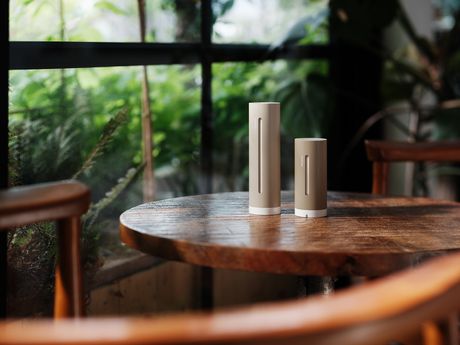
Netatmo presenta la nuova Stazione Meteo ORIGINAL

In poche parole, lo spurgo di un termosifone di acqua calda è un'azione rapida e facile che è necessaria per rimuovere la pressione, le bolle d'aria e il fango dal termosifone. Questi possono impedire al vostro sistema di riscaldamento di funzionare correttamente o addirittura bloccare i tubi. Questa è un'operazione semplice ma importante per evacuare l'aria che è entrata nel sistema di circolazione dell'acqua calda.
Senza spurgo, alla lunga, è possibile che un termosifone non si accenda più. Non è l'ideale se hai davvero bisogno di riscaldamento nell'immediato, soprattutto con l'avvicinarsi dell'autunno! Fortunatamente, potete fare il lavoro da soli senza preoccupazioni. Tutto quello che dovete fare è conoscere la tecnica e prendere alcune piccole precauzioni.
Spurgare i vostri termosifoni è anche un modo efficace per ridurre o eliminare il rumore dei tubi. Ma non è tutto: lo spurgo è anche il modo per ottimizzare le prestazioni del termosifone migliorandone la durata. Infine, potete contare su risparmio energetico: ideale per l'efficienza energetica del vostro sistema di riscaldamento.
Quindi, non esitate a usare la vostra chiave almeno una volta all'anno per mantenere il vostro sistema di riscaldamento e i vostri termosifoni!
Oggi, spurgare il termosifone è ancora più facile grazie alla Testa termostatica intelligente Netatmo : vi permette di controllare la temperatura del vostro termosifone d'acqua in modo più preciso! Ottimizzate il vostro comfort termico, il vostro consumo e il vostro sistema di riscaldamento con questo pratico dispositivo.
Ora sapete perché non è necessario spurgare regolarmente i vostri termosifoni. Ma quando è il momento giusto? Non c'è bisogno di spurgare i vostri termosifoni ogni mese. Tuttavia, si raccomanda di effettuare questo spurgo almeno una volta all'anno, di solito quando il sistema di riscaldamento e la caldaia vengono riavviati in autunno, quando le temperature iniziano a scendere. Di solito, tranne in casi eccezionali, non è necessario spurgare i vostri termosifoni più di una volta all'anno.
Naturalmente, è possibile spurgare alcuni termosifoni quando sembrano non funzionare o le loro prestazioni sembrano diminuire. Inoltre, se uno dei vostri termosifoni non ha più la stessa temperatura su tutta la sua superficie, è probabilmente il momento di uno scarico. Infine, anche in caso di rumori anomali provenienti dai tubi, è necessario spurgare i vostri termosifoni.
In ogni caso, non preoccupatevi: lo spurgo è molto veloce (oltre che facile) e in pochi minuti, sarete in grado di mettere in funzione i vostri termosifoni, ora in perfetto stato di funzionamento!
Prima di iniziare a spurgare il vostro termosifone, assicuratevi di avere un paio di pinze o un cacciavite, una chiave inglese o una chiave di spurgo, una spazzola metallica (se il termosifone è vecchio) e un piccolo contenitore. Si consiglia di iniziare dal termosifone più vicino alla caldaia e finire con quello più lontano (soprattutto nel caso di una casa o di un appartamento con più piani, perché si rischia di dover ricominciare una volta spurgati gli ultimi termosifoni).
Se il vostro termosifone dell'acqua è dotato di uno spurgo (come la maggior parte oggi), girate questa piccola vite sul contorno bianco situato sulla parte superiore del termosifone per spurgarlo. Quando l'aria esce dal tuo termosifone, lo spurgo è (già) completo.
Se il vostro scaldabagno non ha uno sfiatatoio, iniziate a mettere il vostro contenitore sotto la vite di sfiato sul termosifone (situata sul lato opposto della valvola di controllo del calore).
Potete girare questa vite di spurgo o la valvola termostatica per qualche secondo. Tenete le orecchie aperte: dovreste sentire un leggero fischio!
A seconda del modello del termosifone, che sia vecchio o nuovo, il procedimento è diverso. Se il termosifone è dotato di una piccola manopola che termina la vite di spurgo, stringetela senza svitarla completamente.
Se si tratta di un termosifone più vecchio con una chiave di spurgo, rimuovete gli strati di vernice che bloccano la vite di spurgo usando la spazzola metallica. Si può quindi rilasciare la vite e chiuderla di nuovo quando le prime gocce d'acqua escono.
Infine, riavvitate delicatamente la vite, senza forzare. Infine, regolate la valvola termostatica o il rubinetto (completamente aperto) alla temperatura ideale.
Lo spurgo dei termosifoni dell'acqua a volte provoca una diminuzione della pressione nel sistema di riscaldamento. Questo è un problema! Ripristinatelo semplicemente aggiungendo acqua all'interno attraverso la valvola di riempimento del vostro circuito (sotto o vicino alla caldaia).
Aprite questo rubinetto con molta attenzione, iniziate a riempire e chiudetelo non appena l'ago del manometro (misuratore ad ago della vostra caldaia) è alla pressione raccomandata. Questa pressione raccomandata è nella zona verde del quadrante, a 1,5 bar per una casa o un appartamento a un piano, o tra 1,8 e 2 bar per una casa a più piani.
Spurgare il termosifone non è banale, ma fortunatamente è un'azione molto semplice. Pochi strumenti, pazienza, una buona dose di delicatezza e il trucco è seguire alcuni semplici passi! Se avete preoccupazioni, domande o dubbi, è consigliabile chiedere consiglio a un tecnico del riscaldamento, che sarà in grado di aiutarvi, accompagnarvi o addirittura eseguire lo spurgo per voi.

Riscaldamento
Riscaldamento per aria compressa: conviene optare per questo sistema?

Riscaldamento
Perché installare un impianto di riscaldamento a soffitto?

Riscaldamento
Riscaldamento a distanza: una soluzione pratica, economica e connessa

Riscaldamento
Spegnere la caldaia a gas d’estate: è davvero necessario?